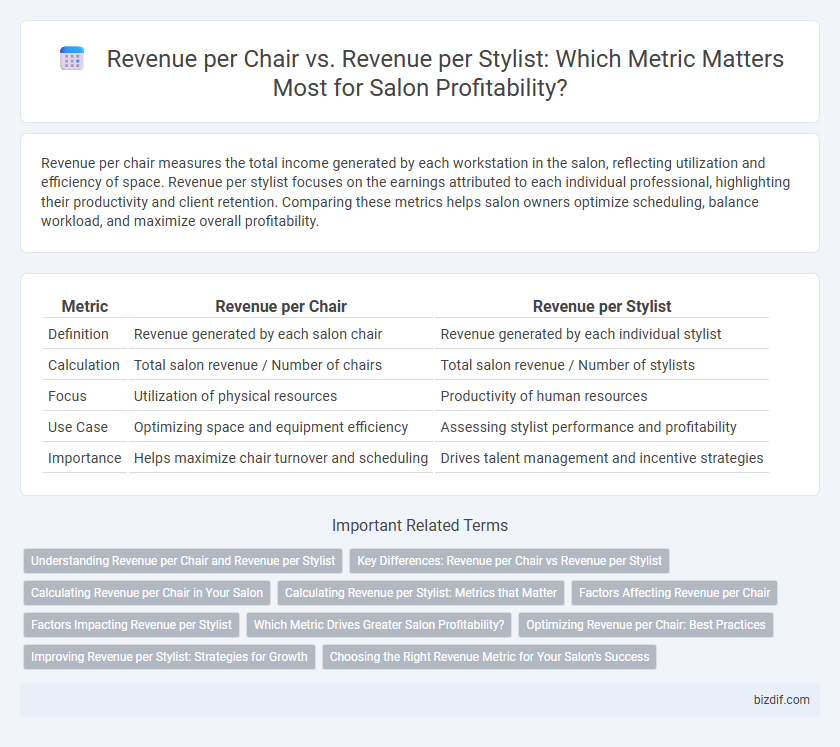Revenue per chair measures the total income generated by each workstation in the salon, reflecting utilization and efficiency of space. Revenue per stylist focuses on the earnings attributed to each individual professional, highlighting their productivity and client retention. Comparing these metrics helps salon owners optimize scheduling, balance workload, and maximize overall profitability.
Table of Comparison
| Metric | Revenue per Chair | Revenue per Stylist |
|---|---|---|
| Definition | Revenue generated by each salon chair | Revenue generated by each individual stylist |
| Calculation | Total salon revenue / Number of chairs | Total salon revenue / Number of stylists |
| Focus | Utilization of physical resources | Productivity of human resources |
| Use Case | Optimizing space and equipment efficiency | Assessing stylist performance and profitability |
| Importance | Helps maximize chair turnover and scheduling | Drives talent management and incentive strategies |
Understanding Revenue per Chair and Revenue per Stylist
Revenue per chair measures the total income generated by each salon station, reflecting the efficiency of space utilization and client turnover. Revenue per stylist accounts for the earnings attributable to individual professionals, highlighting skill impact and service quality on overall profitability. Analyzing both metrics provides a comprehensive view of operational performance and resource allocation within the salon.
Key Differences: Revenue per Chair vs Revenue per Stylist
Revenue per chair measures the income generated by each workstation in the salon, reflecting the overall productivity of the space regardless of how many stylists use it. Revenue per stylist focuses on the earnings attributable to each individual professional, highlighting personal performance and client retention rates. The key difference lies in revenue per chair emphasizing resource utilization, while revenue per stylist underscores individual contribution to the salon's profitability.
Calculating Revenue per Chair in Your Salon
Calculating revenue per chair in your salon involves dividing total salon revenue by the number of chairs available, providing a clear metric for space utilization and financial efficiency. This measurement helps identify underperforming stations and informs decisions on salon layout or service pricing to maximize income. Tracking revenue per chair alongside revenue per stylist enables more strategic resource allocation and targeted improvements in team productivity.
Calculating Revenue per Stylist: Metrics that Matter
Revenue per stylist is a critical metric that provides deeper insight into individual productivity compared to revenue per chair, by accounting for the number of stylists and their individual earnings. Calculating revenue per stylist involves dividing total salon revenue by the number of active stylists, highlighting stylist performance and helping identify training or incentive opportunities. Monitoring this metric allows salon owners to optimize staff allocation, improve service pricing, and increase overall profitability.
Factors Affecting Revenue per Chair
Revenue per chair in a salon is influenced by factors such as chair utilization rates, pricing strategies, and the variety of services offered. High chair turnover and extended operating hours contribute to increased revenue generation per chair. In contrast, revenue per stylist depends on individual productivity, client retention, and skill specialization, which may not directly correlate with the overall revenue per chair.
Factors Impacting Revenue per Stylist
Revenue per stylist is influenced by factors such as the number of clients serviced, average transaction value, and stylist efficiency, which often surpasses revenue per chair due to personalized services and upselling opportunities. Stylist expertise and client retention directly impact revenue generation, as loyal clients typically spend more per visit and return more frequently. Scheduling optimization and effective time management further enhance revenue per stylist by maximizing the number of appointments and reducing idle chair time.
Which Metric Drives Greater Salon Profitability?
Revenue per chair provides a clear measure of space utilization and overall salon efficiency, highlighting how well each physical station generates income. Revenue per stylist reflects individual performance and skill level, which can drive higher service prices and client retention. Analyzing both metrics together reveals that maximizing revenue per chair often leads to greater salon profitability by optimizing capacity, while high revenue per stylist boosts quality and customer satisfaction.
Optimizing Revenue per Chair: Best Practices
Optimizing revenue per chair requires efficient scheduling to maximize chair utilization while minimizing downtime between appointments. Implementing tiered pricing strategies and upselling services can increase earnings associated directly with each chair. Tracking key performance indicators such as average service time and client retention rates helps identify opportunities to boost revenue per chair effectively.
Improving Revenue per Stylist: Strategies for Growth
Maximizing revenue per stylist hinges on effective scheduling, targeted upselling, and continuous training to enhance service quality and client retention. Leveraging advanced appointment management software helps optimize stylist workloads and reduces downtime, boosting overall productivity. Implementing personalized marketing campaigns and incentive programs motivates stylists to increase sales, driving sustained revenue growth.
Choosing the Right Revenue Metric for Your Salon's Success
Measuring revenue per chair highlights the operational efficiency of each salon station, reflecting how well space and resources are utilized to maximize income. Revenue per stylist emphasizes individual performance and skill impact, helping identify top earners and areas needing training or motivation. Selecting the right revenue metric depends on your salon's business model and goals, balancing between optimizing physical assets and enhancing stylist productivity.
Revenue per chair vs Revenue per stylist Infographic

 bizdif.com
bizdif.com